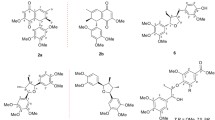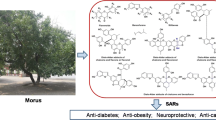Abstract
Coumarinolignans (CLs) are a group of non-conventional lignans having coumarins and phenyl propanes as two C6C3 units linked commonly through a dioxane bridge. The research findings during Jan 2008–May 2018 on this group of secondary metabolites describing their occurrence, structural characteristics, large-scale preparation, synthesis, derivatives, pharmacological activities, and structure–activity relationship are presented in this review. Around 38 CLs have been isolated from 40 plant species belonging to 20 different families during the review period. Reports on the syntheses of CL derivatives are also discussed. The majority of the reported CLs have shown potential anti-inflammatory activities, especially against pro-inflammatory cytokines. The other pharmacological effects exhibited by CLs such as hepatoprotective, anticancer, etc., are also covered in this review comprehending the lacunae in their development into drugs. This article is a continuation of our earlier work on coumarinolignans (Begum SA, Sahai M, Ray AB (2010) Non-conventional lignans: coumarinolignans, flavonolignans, and stilbenolignans. In: Kinghorn AD, Falk H, Kobayashi J (eds) Progress in the chemistry of organic natural products, Springer, Verlag/Wien, p 1–70).





Similar content being viewed by others
References
Ray AB, Chattopadhyay SK (1980) Structure of cleomiscosin A, a coumarinolignoid of Cleome viscosa seeds. Tetrahedron Lett 21:4477–4480
Begum SA, Sahai M, Ray AB (2010) In: Kinghorn AD, Falk H, Kobayashi J (eds) Progress in the chemistry of organic natural products. Verlag/Wien, Springer
Bawankule DU, Chattopadhyay SK, Pal A, Saxena K, Yadav S, Faridi U, Darokar MP, Gupta AK, Khanuja SPS (2008) Modulation of inflammatory mediators by coumarinolignoids from Cleome viscosa in female Swiss albino mice. Inflammopharmacology 16:272–277
Begum S, Saxena B, Goyal M, Ranjan R, Joshi VB, Rao CV, Krishnamurthy S, Sahai M (2010) Study of anti-inflammatory, analgesic and antipyretic activities of seeds of Hyoscyamus niger and isolation of a new coumarinolignan. Fitoterapia 81:178–184
Begum SA (2010) Bioactive non-alakloidal secondary metabolites of Hyoscyamus niger Linn. Res J Seed Sci 3:210–217
Yang J, Liu W, Li S, Ye H, Tang H, Chen L, Peng A (2014) Coumarinolignans isolated from the seeds of Brucea javanica. Helv Chim Acta 97:278–282
Feng J, Wang Y, Yi X, Yang W, He X (2016) Phenolics from durian exert pronounced NO inhibitory and antioxidant activities. J Agr Food Chem. https://doi.org/10.1021/acs.jafc.6b01580
Chen JJ, Wang TY, Hwang TL (2008) Neolignans, a coumarinolignan, lignan derivatives, and a chromene: anti-inflammatory constituents from Zanthoxylum avicennae. J Nat Prod 71:212–217
Cheng L, Zhang X, Zhang M, Zhang P, Song Z, Ma Z, Cheng Y, Qu H (2009) Characterization of chemopreventive agents from the dichloromethane extract of Eurycorymbus cavaleriei by liquid chromatography–ion trap mass spectrometry. J Chromatogr A 1216:4859–4867
Nakashima KI, Oyama M, Ito T, Akao Y, Witono JR, Darnaedi D, Tanaka T, Murata J, Iinuma M (2012) Novel quinolinone alkaloids bearing a lignoid moiety and related constituents in the leaves of Melicope denhamii. Tetrahedron 68:2421–2428
Yim SH, Jung DW, Williams DR, Geckeler KE, Kim KK, Shin BA, Lee IS, Kim HJ (2015) Anti-proliferative effects of β-cyclodextrin inclusion complexes with coumarinolignans from Acer mono. Korean J Pharmacognosy 46:133–139
Yoshikawa K, Kawahara Y, Arihara S, Hashimoto T (2011) Aromatic compounds and their antioxidant activity of Acer saccharum. J Nat Med 65:191–193
Ahmad N, Zeb F, Ahmad I, Wang F (2009) Repenins A–D, four new antioxidative coumarinolignoids from Duranta repens Linn. Bioorg Med Chem Lett 19:3521–3524
Sielinou VT, Vardamides JC, Nkengfack AE, Laatsch H (2012) Phenolic derivatives and an antifungal and cytototoxic labdane diterpenoid from the root bark of Turraeanthus mannii. Phytochem Lett 5:409–413
Demirkiran O, Topcu G, Azarpira A, Choudhary MI (2014) Tyrosinase inhibitory activity of chemical constituents of Euphorbia macrostegia. Chem Nat Compd 50:810–813
Ahn JH, Shin E, Liu Q, Kim SB, Choi KM, Yoo HS, Hwang BY, Lee MK (2012) Lignan derivatives from Fraxinus rhynchophylla and inhibitory activity on pancreatic lipase. Nat Prod Sci 18:116–120
Yamada K, Subeki Nabeta K, Yamasaki M, Katakura K, Matsuura H (2009) Isolation of antibabesial compounds from Brucea javanica, Curcuma xanthorrhiza and Excoecaria cochinchinensis. Biosci Biotechnol Biochem 73:776–780
Chen QJ, Ouyang MA, Tan QW, Zhang ZK, Wu ZJ, Lin QY (2009) Constituents from the seeds of Brucea javanica with inhibitory activity of tobacco mosaic virus. J Asian Nat Prod Res 11:539–547
Zhang H, Song ZJ, Chen WQ, Wu XZ, Xu HH (2012) Chemical constituents from Aglaia odorata Lour. Biochem Syst Ecol 41:35–40
Cao S, Brodie PJ, Callmander M, Randrianaivo R, Rakotobe E, Rasamison VE, Kingston DGI (2010) Saponins and a lignan derivative of Terminalia tropophylla from the Madagascar dry forest. Phytochemistry 71:95–99
Kuang HX, Xia YG, Yang BY, Wang QH, Lü SW (2009) Lignan constituents from Chloranthus japonicus Sieb. Arch Pharmacal Res 32:329–334
Dzoyem JP, Donfack ARN, Tane P, McGaw LJ, Eloff JN (2016) Inhibition of nitric oxide production in LPS-stimulated RAW264.7 macrophages and 15 LOX activity by anthraquinones from Pentas schimperi. Planta Med 82:1246–1251. https://doi.org/10.1055/s-0042-104417
Bai B, Gu XW, Chen Y, Guan FQ, Shan Y, Feng X (2015) Virginicin, a new naphthalene from Kosteletzkya virginica (Malvaceae). J Braz Chem Soc 26:1–9
Liu B, Xu YK (2015) Cytotoxicity and synergistic effect of the constituents from roots of Aglaia odorata (Meliaceae). Nat Prod Res. https://doi.org/10.1080/14786419.2015.1016940
He ZZ, Yan JF, Song ZJ, Ye F, Liao X, Peng SL, Ding LS (2009) Chemical constituents from the aerial parts of Artemisia minor. J Nat Prod 72:1198–1201
Chen D-L, Li G, Liu Y-Y, Ma G-X, Zheng W, Sun X-B, Xu X-D (2018) A new cadinane sesquiterpenoid glucoside with cytotoxicity from Abelmoschus sagittifolius. Nat Prod Res. https://doi.org/10.1080/14786419.2018.1431635
Erwin Noor A, Soekamto NH, Altena IV, Syah YM (2014) Waltherione C and cleomiscosin from Melochia umbellata var. Degrabrata K. (Malvaceae), biosynthetic and chemotaxonomic significance. Biochem Syst Ecol 55:358–361
Donfack ARN, Tala MF, Wabo HK, Jerz G, Zeng GZ, Winterhalter P, Tan NH, Tane P (2014) Two new anthraquinone dimers from the stem bark of Pentas schimperi (Rubiaceae). Phytochem Lett 8:55–58
Zhang ML, Irwin D, Li XN, Sauriol F, Shi XW, Wang YF, Huo CH, Li LG, Gu YC, Shi QW (2012) PPARγ agonist from Chromolaena odorata. J Nat Prod. https://doi.org/10.1021/np300386d
Yadav NP, Chanda D, Chattopadhyay SK, Gupta AK, Pal A (2010) Hepatoprotective effects and safety evaluation of coumarinolignoids isolated from Cleome viscosa seeds. Indian J Pharm Sci 72:759–765
Xu JF, Feng ZM, Liu J, Zhang PC (2008) New hepatoprotective coumarinolignoids from Mallotus apelta. Chem Biodivers 5:591–597
Yin HL, Li JH, Li J, Li B, Chen L, Tian Y, Liu SJ, Zhang T, Dong JX (2013) Four new coumarinolignoids from seeds of Solanum indicum. Fitoterapia 84:360–365
Ferheen S, Rehman A-U, Rasool MA, Naqvi B, Imran M, Khan RA, Kalhoro MA, Malik A (2014) Anti-tuberculosis coumarinolignans from Daphne mucronata. Asian J Chem 26:7262–7264
Tandon S, Chatterjee A, Chattopadhyay SK, Kaur R, Gupta AK (2010) Pilot-scale processing technology for extraction of Cliv-92: a combination of three coumarinolignoids cleomiscosins A, B and C from Cleome viscosa. Ind Crops Prod 31:335–343
Kuboki A, Yamamoto T, Taira M, Arishige T, Konishi R, Hamabata M, Shirahama M, Hiramatsu T, Kuyama K, Ohira S (2008) Reversal of the regioselectivity in a cycloaddition of o-quinones by varying the position of alkoxy substituents. Tetrahedron Lett 49:2558–2561
Kuboki A, Maeda C, Arishige T, Kuyama K, Hamabata M, Ohira S (2008) Total synthesis of cleomiscosin C via a regioselective cycloaddition reaction of o-quinone. Tetrahedron Lett 49:4516–4518
Sharma S, Chattopadhyay SK, Trivedi P, Bawankule DU (2010) Synthesis and anti-inflammatory activity of derivatives of coumarino-lignoid, cleomiscosin A and its methyl ether. Eur J Med Chem 45:5150–5156
Sharma S, Chattopadhyay SK, Yadav DK, Khan F, Mohanty S, Maurya A, Bawankule DU (2012) QSAR, docking and in vitro studies for anti-inflammatory activity of cleomiscosin A methyl ether derivatives. Eur J Pharm Sci 47:952–964
Begum AS, Kumar SS, Gottapu S, Hira K (2018) O-Glucoside of natural cleomiscosin-A: an attenuator of pro-inflammatory cytokine production. Phytochem Lett 26:83–87
Chattopadhyay S, Srivastava S, Negi A, Gupta A, Khanuja S (2004) Hepatoprotective pharmaceutical composition comprising a mixture of coumarinolignoids, process for the preparation thereof. US patent 20040191343
Ranjan R, Sahai M (2009) Coumarinolignans from the seeds of Annona squamosa Linn. E J Chem 6:518–522
Li D, Jiang YY, Jin ZM, Li HY, Xie HJ, Wu B, Wang KW (2016) Isolation and absolute configurations of diastereomers of 8α-hydroxy-T-muurolol and (1α,6β,7β)-cadinane-4-en-8α,10α-diol from Chimonanthus salicifolius. Phytochemistry 122:294–300
Wang KW, Li D, Wu B, Cao XJ (2016) New cytotoxic dimeric and trimeric coumarins from Chimonanthus salicifolius. Phytochem Lett 16:115–120
Kan S, Chen G, Han C, Chen Z, Song X, Ren M, Jiang H (2011) Chemical constituents from the roots of Xanthium sibiricum. Nat Prod Res 25:1243–1249
Das B, Ravikanth B, Reddy KR, Thirupathi P, Raju TV, Sridhar B (2008) Diterpenoids from Jatropha multifida. Phytochemistry 69:2639–2641
Torres MCM, Braz-Filho R, Silveira ER, Diniz JC, Viana FA, Pessoa ODL (2010) Terpenoids from Croton regelianus. Helv Chim Acta 93:375–381
Aichour S, Haba H, Benkhaled M, Harakat D, Lavaud C (2014) Terpenoids and other constituents from Euphorbia bupleuroides. Phytochem Lett 10:198–203
Soh RF, Bankeu JK, Lenta BN, Mbaning BM, Ngouela S, Tsamo E, Sewald N (2009) Antibacterial ellagic acid derivatives and other constituents from Pancovia pedicellaris. Z Naturforsch B 64b:1070–1076
Xiang-Yun Z, Xiang-Hai C, Xiao-Dong L (2012) Chemical constituents of Allophylus longipes. Chin J Nat Med 10:36–39
Zhao M, Lau ST, Zhang XQ, Ye WC, Leung PS, Che CT, Lin ZX (2011) Bruceines K and L from the ripe fruits of Brucea javanica. Helv Chim Acta 94:2099–2105
Begum S, Sahai M, Suessmuth R, Asai T, Hara N, Fujimoto Y (2006) Hyosgerin, a new optically active coumarinolignan from the seeds of Hyoscyamus niger. Chem Pharm Bull 54:538–541
Rasool MA, Khan R, Malik A, Bibib N, Kazmib SU (2010) Structural determination of daphnecin, a new coumarinolignan from Daphne mucronata. J Asian Nat Prod Res 12:324–327
Michalet S, Payen-Fattaccioli L, Beney C, Cegiela P, Bayet C, Cartier G, Noungoue-Tchamo D, Tsamo E, Mariotte AM, Dijoux-Franca MG (2008) New components including cyclopeptides from barks of Christiana Africana DC. (Tiliaceae). Helv Chim Acta 91:1106–1117
Kang YM, Lee NH (2011) A new isoflavone glycoside from the stems of Tilia taquetii Schneider. Bull Korean Chem Soc 32:1048–1050
Uddin G, Ullah W, Siddiqui BS, Shah SQ (2013) Grewialin and optivanin new constituents from the stem bark of Grewia optiva Drummond ex Burret (Tiliaceae). Nat Prod Res 27:215–220
Ahn JH, Hwang BY, Lee MK (2013) Simultaneous quantitation of nine constituents of Fraxinus rhynchophylla using high performance liquid chromatography—diode array detector. Nat Prod Sci 19:236–241
Liu H-B, Zhang H, Yu J-H, Yue J-M (2016) New diterpenoids from Sapium discolor. J Asian Nat Prod Res 17:1117–1128. https://doi.org/10.1080/10286020.2015.1119665
Hsiao P-Y, Lee S-J, Chen I-S, Hsu H-Y, Chang H-S (2016) Cytotoxic cardenolides and sesquiterpenoids from the fruits of Reevesia formosana. Phytochemistry. https://doi.org/10.1016/j.phytochem.2016.06.009
Tan T, Luo Y, Zhong C-C, Xu X, Feng Y (2017) Comprehensive profiling and characterization of coumarins from roots, stems, leaves, branches, and seeds of Chimonanthus nitens Oliv. using ultra-performance liquid chromatography/quadrupole-time-of-flight mass spectrometry combined with modified mass defect filter. J Pharm Biomed Anal 141:140–148. https://doi.org/10.1016/j.jpba.2017.04.016
Maffo T, Melong R, Nganteng DND, Wafo P, Ali MS, Ngadjui BT (2018) Neomacrodione: a new degraded diterpenoid from the roots of Neoboutonia macrocalyx Beng (Euphorbiaceae). Nat Prod Res 32:85–90
Acknowledgements
The authors gratefully thank the Council for Scientific and Industrial Research (CSIR), New Delhi, India (02(0045)/12/EMR-II), for financial assistance. SKS thankfully acknowledges BITS-Pilani for Senior Research Fellowship.
Author information
Authors and Affiliations
Corresponding author
Ethics declarations
Conflict of interest
No potential conflicts of interest are reported by the authors.
Rights and permissions
About this article
Cite this article
Begum, A.S., Kumar, S.S. Advances in the chemistry and pharmacological potential of coumarinolignans. Top Curr Chem (Z) 376, 34 (2018). https://doi.org/10.1007/s41061-018-0212-5
Received:
Accepted:
Published:
DOI: https://doi.org/10.1007/s41061-018-0212-5




